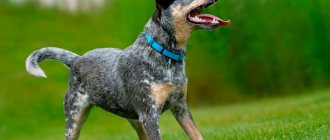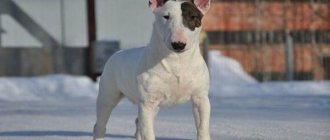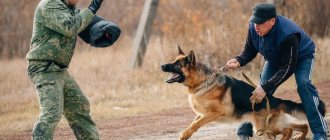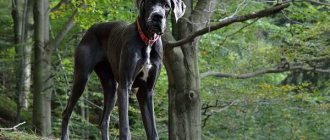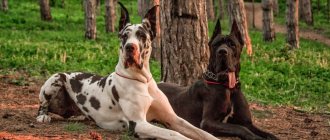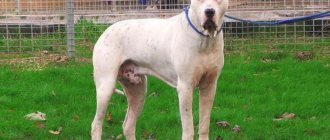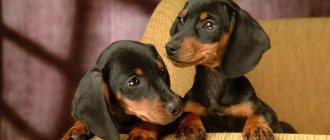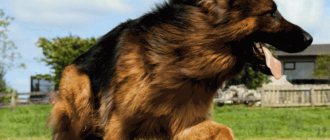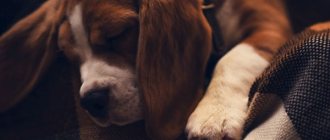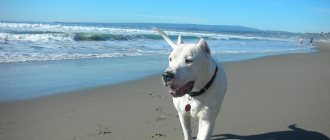History of the Dogo Canario breed
The origin of the breed occurred on the islands of Tenerife and Gran Canaria. It is believed that the cattle dogs Mahorero, bred since ancient times by the Guanche tribes, as well as the Roman Molossians, which were brought to the Canaries later, took part in the formation of the genotype of the animals. For a long time, Presa Canarios bred freely in the territories of the archipelago, and their main area of activity was protecting the owner’s property and grazing livestock.
In the 15th century, the Canaries were appropriated by the Spaniards, partially exterminating and partially sending the indigenous population into captivity. The military conflict also affected dogs. In the devastated ashes, the animals had nothing to guard, so a new job was invented for them - fighting and baiting wild animals. Thus, Canary dogs retrained as gladiators who staged public performances, which at first were not particularly cruel.
Aggression and suspicion came to the breed later, when its representatives were pumped up the gene pool by crossing Presa Canario with English bulldogs and mastiffs brought to Tenerife. The offspring from these matings had great viciousness and reaction speed, so the Spanish authorities considered the breed dangerous, allowing it to be kept only by butchers. Individuals belonging to owners of other professions were destroyed. Great Danes continued their fighting career, for the sake of which they were bred with other four-legged “aggressors” such as Staffords and Boxers. Subsequently, this led to the loss of the animals' native appearance and stratification into breed types.
Since the second half of the 20th century, dog fighting was banned, and the Dogo Canario family fell into decline. Perhaps the breed would have disappeared if Spanish enthusiasts had not taken up the challenge of reviving it. The animals' phenotype was once again updated, adding the genes of Rottweilers, Great Danes and Mastino Neapolitanos, and in 1982 the national Presa Canario club began operating. In 1986, the first exhibitions of Dogo Canarios started in Spain, in 1989 the breed was standardized, and in 2001 its representatives were officially registered by the FCI.
History of origin
The Dogo Canary is one of the largest dog breeds.
This Spanish Canary dog is widespread in Spain and the Canary Islands. It is especially popular in Tenerife. The history of this dog began several hundred years ago. However, despite this, until the beginning of 1989 this breed was not officially registered.
Currently, this dog has several different names:
- dogo canario;
- Canary Mastiff;
- Canadian Great Dane;
- perro de presa canario;
- Great Dane
In the first few years after the formation of the breed, such dogs were used in battles and to guard livestock. Nowadays they are most often used to protect a private home.
Additional Information! The Presa Canario is the official symbol of the island of Gran Canaria.
Breed standard Dogo Canario
Presa Canario resembles a Cane Corso with its molossoid, distinctly brutal appearance. The breed's weight category is also serious: a proper male must gain at least 50 kg of live weight, while females are allowed to stop at 40 kg. “Girls” also have other external differences. For example, females have a more elongated body format. In addition, they are much shorter than their partners: only 56-61 cm versus 64-68 cm noted in males. The “wild” tiger color adds texture and charisma to the breed, as well as small folds of skin on the face, reminiscent of its mastiff ancestors.
Head
The strong, massive head of the Dogo Canario has the shape of an elongated cube. The ratio of the length of the skull to the muzzle is approximately 60:40. The skull is moderately convex with prominent cheekbones, a smoothed occipital protuberance and freely hanging skin. The stop is quite noticeable, but not steep, with a well-defined middle fold. A characteristic feature of the breed is a flat, straight muzzle with a wide base, only slightly tapering at the tip.
Teeth, jaws, lips
When they touch each other, the lips form an inverted V shape, with the upper lips hanging down slightly. The jaws are massive with developed fangs, large molars and relatively small front teeth. The standard bite types are scissor bite and tight bite. Direct jaw closure is acceptable, but undesirable, as it contributes to tooth abrasion.
Nose
The brightly pigmented lobe with large nostrils is stretched wide. The front of the nose protrudes slightly above the dog's lips.
Eyes
The Dogo Canary has large or medium-sized eyes that are harmoniously set - that is, not protruding, but not deep-set either. The eyeballs are covered by dense, brightly pigmented eyelids. The classic color of the iris is from chestnut to dark brown.
Ears
The ears, hanging freely on the sides of the skull, are far apart from each other. The ear flap itself is small in size, closely fitting to the head and, when folded, resembles a pink petal. Often the ears are cropped, in which case the organ takes the correct standing position.
Neck
The Dogo Canario's neck resembles a cylinder with well-developed muscles and a slight dewlap in the front.
Frame
The body of a purebred individual must be massive, strong and exceed the height of the animal at the withers in length by at least 18-20%. The back is straight, but with a slight rise between the croup and withers. The croup of Great Danes is developed, and this part of the body looks more massive in females. A mandatory requirement of the breed standard is a wide chest with strongly arched ribs and a slightly tucked belly line.
Limbs
Dogo Canarios have muscular, parallel limbs that provide an elastic, long stride when moving. The breed's shoulders are set at the correct angle, the elbows do not turn out to the sides, the pasterns are massive with a slight bend. When viewed from the rear and sides, the animal's thighs appear elongated and muscular, and the hocks appear low. All four paws have tightly pressed, rounded toes and hard black pads, with the front paws being shorter than the hind paws. Claws are always black.
Tail
The Dogo Canario's tail has a medium set, it is very massive at the base and tapered at the tip. A calm dog has a tail that hangs down, but does not reach the hocks; in an excited one, it takes on a saber shape, rises towards the back, but never curls.
Wool
Formally, “Canaries” do not have undercoat, but in practice it can be found in the neck and buttock areas. The outer hair is short, even and hard. The longer hair is on the hips and withers, the shortest is on the outside of the ears.
Color
Traditional colors of the breed are all types of brindle: from light gray to warm shades. Additionally, the standard allows the breeding of fawn and sand colored individuals. There is a black mask on the Dogo Canario's face. In addition, there may be contrasting white markings on the neck and toes, which are undesirable.
Disadvantages and disqualifying vices
An ideal show pet must fit into the parameters specified by the standard in all respects. If the dog has noticeable defects in appearance, such as general fragility of appearance, atypical skull shape and disturbed proportions, this will greatly affect the exhibition rating. As for the ban on exhibiting, a Dogo Canario that has the following appearance defects can receive it:
- heterochromia or too light eyes;
- white marks on the fur in places not specified by the standard;
- undershot;
- no black mask;
- depigmented skin of the lips, eyelids and earlobes;
- keeled chest;
- cryptorchidism;
- the croup below the level of the withers.
Individuals with docked tails and those with atypical behavior are not allowed for exhibitions and breeding. Usually these are overly cowardly or aggressive animals that are difficult to control in the ring.
Description
A large dog, with a muscular and strong body. Males at the withers reach 58-66 cm, weight from 45 to 65 kg. Bitches are from 56 to 64 cm at the withers, weigh from 39 to 55 kg.
The head is massive, wide, square, brachycephalic type. The correct head shape is part of the breed standard and a distinctive feature of its best representatives.
Traditionally, ears are cropped in order to reduce the number of vulnerable spots in dogs and to give it a more severe expression.
In this case, the ears stand straight, but in many countries it is prohibited to crop the ears. In this case, the shape of the ears is hanging, in the form of a rose.
The upper lip hangs down, when viewed from the front, the shape of the upper and lower lip forms an inverted V. The inside of the lip is dark in color.
Character of the Dogo Canario
Presa Canarios are no longer gladiators or game hunters, but their territorial instinct is still strong. That is why it is better to acquire a Dogo Canary when there is a need for a protector and a sensitive watchman. In everyday life, tiger “jocks” are quite balanced and calm, but they do not fall out of reality, preferring to keep the situation under control. Hence - distrust of strangers and suspicion of everyone who tries to come into close contact with the owner. In relations with fellow tribesmen, Canary Dogoes are reasonable and restrained, but only until the first provocation. Once the intensity of passion reaches its peak, it is impossible to stop the dog.
Attacking without warning is not in the rules of Presa Canario, so if the animal growls, stands up and shows its fangs, this signals that it is time to immediately retreat. It is generally not recommended to run away from the natives of Tenerife unless you want to provoke the dog to more radical measures. Dogo Canarios have a peaceful and trusting relationship with children. A formidable “bodyguard” can do a lot for kids, so if you see a dog pushing kids on a sled, this is not a staged show, but a completely ordinary occurrence for a family in which the dog and children trust each other. However, you shouldn’t rely recklessly on the animal’s patience: for all their love of children, Canary Dogs are not among the top four-legged nannies that you can leave your kids with.
The breed does not compete with other pets for spheres of influence, especially if these same pets are smaller in size than Great Danes. When getting a Presa Canario puppy, it is not necessary to evict cats and dogs of decorative breeds from your home. Living side by side, the animals gradually get used to each other and do not conflict. Dogo Canarios prefer to find out who is boss in the house among themselves, so if you plan to become the owner of two males or females, prepare for friction between your charges. In everyday life, the descendants of Roman Molossians are unpretentious; if the owner has no desire to communicate, they easily blend into the interior. Another distinctive character trait of the breed is slight stubbornness, which you just need to accept.
Character of the breed
The Canary Mastiff (sometimes this breed is also called that) has a tough and difficult character, thanks to which it manages to be an excellent protector, an understanding but vigilant companion and a good watchman. Of course, such qualities directly depend on the upbringing of the Dogo Canario.
From birth, the Canary Mastiff is capable of keeping everything under surveillance and also guarding a large territory. At the same time, the dog knows how to look after not only animals, but also people.
Attention! As the description of the breed says, the Canary Mastiff is a dog of only one owner, whom the pet chooses for itself. But other family members can easily play with the dog, pet it and feed it, but they don’t need to try to raise the animal, otherwise it’s unclear how the dog will react to this.
The Dogo Canario has a lightning-fast reaction - it can play happily with its owner, but if the animal notices a stranger, it will immediately become angry and ferocious (see video). It is worth noting that only the owner’s command can ward off a dog’s attack.
It is important to note that if the intruder is calm, the Canary Mastiff will not attack - he will only growl, grin and stand in an aggressive pose.
As the description of the breed says, a Great Dane will be a good companion for a child, but it is still not worth getting such a serious and aggressive dog for children.
Education and training
The Dogo Canario is a dog for which early socialization is important. Whatever ordinary people say about the bloodthirstiness of the breed, in 9 cases out of 10 it is due to improper integration of the animal into the home and street environment. All the work of accustoming the puppy to the sounds, smells and surprises of the surrounding world falls on the shoulders of the owner, as well as responsibility for the pet’s behavior. So be prepared to put in some serious work before you get a well-mannered and calm guardian, rather than an explosive aggressor who creates problems with others and the law.
Inexperienced owners mistakenly understand by socialization the ability of the Dogo Canary to join the canine community, as well as the cultivation of the habit of not being frightened by sharp sounds, public transport and other external irritants. As a result: on the very first walks, they try to “make friends” with the puppy’s fellow tribesmen resting nearby, instead of trying to explain the basic truths to the baby on their own. Remember, in the first months of life, a person remains a mentor and parent for a dog, not its relatives. It is with the owner that the baby must walk and obey him.
Attempts to replace the authority of the owner with the participation of other family members in the educational process do not count. There must be one teacher, otherwise the Dogo Canary will quickly realize that there is no leader in the house and will take its own benefit from the situation. By the way, about the dominant traits of the breed: they manifest themselves extremely clearly in adolescence, although, having matured, the “Canary” will try to imagine himself as a superman. In this regard, the dog will have to be regularly reminded that he is not the center of the Universe.
Do not forget that the dog should never enter or leave the apartment ahead of the person. Attempts to grumble and bite when the owner takes away the toy should be stopped immediately (take it away, but do not scream or hit the puppy). Don't let your pet lie on the bed or interfere with your access to any room in the house. Without stopping such behavior, you equalize the rights of the animal with yourself, which stimulates it to further disobedience.
Dogo Canarios are trained using the same methods as all leading dogs. Practice basic commands like “Sit!”, “Walk!”, “Place!” even a novice owner is able to do this, since the breed’s memory and intelligence are excellent. To ensure the safety of others and the ability to appear with a dog in public places, it is enough to complete the UGS and OKD courses. If a sports career is planned for the “Canary”, it’s worth going with him to the training grounds. Dogs involved in sports must work automatically and immediately execute commands.
Important: Dogo Canary can be used in sports disciplines no earlier than the animal is one year old. Like most large breeds, Presa Canarios do not have very strong joints, so exercising too early can have a negative impact on their health.
If you wish, you can also try complex training, which allows you to develop the Dogo Canario’s skills of obedience and protection of the owner. The ideal option is to allow yourself and the puppy individual lessons with a dog handler. A professional will quickly determine the pet’s psychotype, select methods for managing it and give useful advice on suitable training methods.
Training
Dogo Canarios are smart, quick-witted and obedient. They quickly absorb information and remember it easily. But during the learning process they can show stubbornness and independence. Therefore, education must be carried out firmly and persistently. When giving a dog a command, you need to ensure that it is followed, and then be sure to praise the pet.
Training this type of dog must be approached very responsibly. The slightest misbehavior and cruelty on your part can lead to you getting an uncontrollable dog, dangerous not only to society, but most of all to you and the life of your family.
Canaries should be raised by a strong-willed person with a strong character. This is a serious dog that desperately needs proper training.
It would be more advisable to take your pet through a special general training course, as well as a guard service course under the guidance of a dog handler who has experience in training such breeds.
Maintenance and care
Since Dogo Canarios come from a tropical climate, it is difficult for them to put up with Russian weather realities. For this reason, dog handlers recommend keeping the breed in houses and apartments, allowing them to move into an enclosure or yard during the summer. Otherwise, the natives of Tenerife are undemanding pets, for whom it is enough to be provided with a separate bed, bowls for food and drink, and a couple of toys. The dog, by and large, does not need all the rest of his belongings. The only caveat: take into account the size of the breed and select larger toys so that the animal does not have the opportunity to swallow them. It is better to throw away spoiled and bitten objects of the Dogo Canario's amusement without regret. If the tiger “athlete” manages to gut the toy, there is a risk that he will manage to swallow a piece of plastic or rubber, and this leads to unpleasant consequences and standing in line at the veterinary office.
Walk
The Dogo Canario is not as pronouncedly brachycephalic as, for example, the English bulldog, which does not prevent it from suffering from excessive heat. In the summer heat, you need to walk with your pet less, moving the promenades to early morning and late evening. Despite the fact that the Presa Canario is not included in the Russian list of potentially dangerous breeds, it is recommended that the dog be taken out into public places on a leash and wearing a muzzle, and the “equipment” must also be worn by individuals who have flawlessly passed the obedience standards. Harnesses with weights, which are sometimes recommended for walking large breeds, are best not used in the case of “Canaries”. The descendants of the Roman Molossians are already heavy dogs; they don’t need extra stress on their joints and spine.
Free walking is possible in a private fenced area, as well as in deserted places, for example, in vacant lots or in the forest. Forethought is also important. Sometimes collisions with ill-mannered charges of other dog owners lead not only to conflict between owners, but also to injuries to pets. If you see a shrill decorative fluffy or an aggressive “Caucasian” being walked nearby, move away with your pet. Canary dogs almost never provoke a fight, but they also do not intend to give in to presumptuous fellow tribesmen.
Hygiene
Caring for the short coat of a Dogo Canario is not difficult: the dogs are washed once every 3-6 months, and twice a week they go over the coat with a brush or rubber mitten to collect dead hairs and massage the skin. Formally, the breed is devoid of undercoat, but in practice it is often present on the dog’s neck and hips, so periodically it is better to strip these areas, that is, pluck out the dead down layer by hand.
Grooming of the breed is not regulated by the standard, but in the USA it is customary to cut the Canaries' hair. Basically, these manipulations are performed with show animals: a haircut helps to emphasize the ideal areas of the figure, diverting the attention of the evaluation committee from the less “successful” parts of the body. Buying dog cosmetics such as conditioners and coat sprays is also important for owners of show dogs. But if you want to give your pet’s “costume” more shine without spending extra money, a solution of table vinegar, vodka and water will do the job perfectly. It is enough to moisten a cloth in it and rub it over the fur.
Once a week, it’s worth taking the time to examine your dog’s ears. If dirt or excess wax is found inside the funnel, they should be removed with a clean cloth soaked in phytolotion or using ear cleaning drops. The eyes should be examined daily, wiping them a couple of times a week with a cloth moistened with a strong tea infusion or chamomile decoction. In addition, every month the Dogo Canary needs to have its claws shortened, which is more convenient to do with a nail clipper for large breeds.
Brushing your teeth is also one of the mandatory procedures, which will have to be organized at least twice a week. If you don’t risk brushing your Dogo Canario’s teeth yourself, buy oral sprays and gels. It is enough to partially apply them to the animal’s teeth - then, mixing with saliva, the products are independently distributed in the mouth. Store-bought hard treats and natural tomato juice work well to clean plaque.
Feeding
The main source of protein in the Dogo Canario's diet should be lean, sinewy meat with a lot of cartilage tissue. A couple of times a week, it is useful to replace the meat part with frozen fish fillets or offal (liver, kidneys, heart, lungs), not forgetting to increase the portion size due to the reduced nutritional value of the listed products. By the way, in order to satisfy the appetite of such a large dog as the Dogo Canary, it is better to cook porridge with meat - buckwheat, oatmeal, rice.
Adult Canarians cannot drink milk - it is not absorbed by the body. But buttermilk, low-fat kefir and cottage cheese are allowed. Poultry is suitable for puppies and teenagers, as it is rich in amino acids. But in this case, it is important to know that the dog is completely healthy, since there are diseases for which any bird is contraindicated. Additionally, breeders recommend introducing dietary supplements with chondroitin and glucosamine into the food of young dogs, which help to avoid joint problems that often occur in teenage Great Danes.
Chicken eggs and algae are also sources of useful microelements and vitamins. Be sure to include vegetables in the Dogo Canarian menu. For example, cabbage and beets must be heat-treated, but carrot chips can be given raw. You can diversify your dog's diet with fresh berries and rye bread crackers. The body's need for fats can easily be satisfied with butter and unrefined vegetable oil, but it is important not to overdo it so as not to cause stomach upset.
Determining which dry food is suitable for the Dogo Canary will have to be done by selection, so mistakes and blunders in this matter are inevitable. If you don’t want to experiment on your four-legged friend, try leaving him on the “drying” that was bought by the breeder who sold you the dog - sometimes this method works. And of course, don’t skimp on your animal by choosing budget brands. Not only do cheap foods contain virtually no meat, they also cause problems with digestion and kidneys.
Conditions of detention
The Dogo Canario is large in size, so keeping it in a small apartment or house will be very difficult
If the place allows, then it does not matter at all where exactly the pet will live - in the city or outside it. His need for physical activity is average, walks should be daily, but no more than 1–2 hours
It is important to take into account the climatic factor: in the cold season, a short-haired dog needs to be additionally insulated with special clothing.
Before purchasing a puppy, it is important to consider that the breed in some countries is considered dangerous and the possibilities of keeping it are limited. Prohibitions apply in:
- Italy (breed restricted);
- Romania (walking without a muzzle is prohibited);
- USA (possession prohibited in certain states);
- in Bermuda (prohibited);
- Australia (import into the country is prohibited);
- Belarus (the breed is included in the list of potentially dangerous, it can only be kept in a securely fenced area, wearing a reinforced leash, collar and muzzle is mandatory, and walking by persons under 18 years of age is prohibited).
Health and diseases of Dogo Canarios
The most common disease of Dogo Canarios is hip and elbow dysplasia. The disease is inherited from parents, so early diagnosis of producers is an important nuance that should not be overlooked. Sometimes representatives of the breed are diagnosed with Wobbler syndrome, epilepsy and multifocal retinopathy, but this does not happen as often as in the case of dysplasia. Another important feature of Presa Canario is its tendency to volvulus of the intestines and stomach. This is usually due to overfeeding, as well as non-compliance with the regime (walking and sports training immediately after eating). Otherwise, Canary Dogs are quite healthy and strong creatures, with careful care they live no less than other large breeds, that is, up to 10-12 years.
Features of character and behavior
Today, the Dogo Canario is a calm, balanced dog, capable of making independent decisions. She inherited such qualities from her ancestors, who for many centuries helped the indigenous population in shepherding. Pets of this breed are unique, since they can perform such diverse functions with equal success - a companion and a watchman.
They are affectionate, obedient and at the same time ruthless when it comes to protecting the owner, members of his family and property. Despite the “fighting” past, the breeders have done a lot in the process of restoring the breed to ensure that the Dogo Canario’s behavior is controlled and its character is conflict-free. However, the breed requires constant training and skill in managing service dogs.
There are widely known cases of Canarian dogs attacking their owners. This happened in 2001 and 2006 in the USA and was fatal. Therefore, a number of countries, for example, Australia and New Zealand, prohibit the import of these animals. In accordance with the ICF classification, the Dogo Canario does not pass performance tests, which does not prevent it from being actively involved in the protection of livestock, territory and human life.
Advantages
The Dogo Canario has many advantages:
- Smart, quick-witted, capable of “setting goals and objectives.” Can act deliberately, in accordance with the situation.
- High level of trainability, significant degree of obedience after appropriate training, observant.
- Strong, confident, fearless, and in most cases calm. The standard is considered controlled moderate aggression.
- Balanced type of temperament, stable psyche.
- An ideal protector, has a heightened sense of territoriality, controls borders.
- Devoted, faithful, does not tolerate separation from his owner, to whom he quickly and strongly becomes attached.
- An intimidating appearance, especially in a situation where protection is required.
- Moderately active, does not require intense exercise.
- Easy care.
Flaws
Despite the fact that the Dogo Canario has a lot of advantages, the dog has a number of negative character traits:
- Early socialization and ongoing training/behavior correction courses are required.
- Pronounced dominant qualities in relation to relatives of the same sex.
- Anger, distrust of strangers and outsiders. In the case of using a dog to guard the territory, this is an advantage.
- Can attack without warning.
- Not suitable for families with small children; excessively active movements of younger members of the “pack” may be perceived as a threat.
- Absolutely not suitable for inexperienced owners, people with a mild character, and the elderly. It takes strength, rigor and persistence to achieve unquestioning obedience.
How to choose a puppy
- Make sure the sires of the litter have successfully passed testing for genetic joint dysplasia.
- Try to get as much information as possible about the puppy’s ancestors from the seller. Do not forget that Dogo Canarios continue to exist in different breed types, differing both in appearance and temperament.
- Among breeders, the offspring of Spanish and Polish lines are especially valued, so if you are offered a puppy from “Poles” or “Spaniards”, this is a big plus.
- Since it is easy for an inexperienced owner to confuse a Dogo Canario with a Cane Corso, it is better to go with a breed specialist for the first meeting with the puppy and the seller.
- If possible, get to know all the animals from the litter and test their courage - whether they are afraid of the presence of a stranger, how they react to sharp sounds. Give preference to moderately brave, inquisitive, but not aggressive kids.
- Ask the breeder to show the breeding bitch. It is from the parent that puppies often inherit character traits and habits.
Dossier
Adult height: male 60-66 cm, female 56-62 cm. Weight: male 50-59 kg, female 38-50 kg. Characteristic color: brindle of all shades, sand, a dark mask on the face is required, white markings on the limbs and body are acceptable. Coat length: short, hard, without undercoat. Life expectancy: from 9 to 15 years. Advantages of the breed: smart, obedient and loyal to the owner. Characterized by courage and determination. Difficulties of the breed: can be aggressive, require training. Average price: $600-3000, depending on pedigree and gender. Classification: large breed, fighting, guarding, herding.
Content Features
It is not recommended to keep the Spanish Mastiff in an apartment. It is almost impossible to raise a healthy puppy on parquet or laminate flooring; in the house the dog will be deprived of proper walking
It is very important that the dog has the opportunity to move enough - as much as he wants and when he wants
The dog must have a territory that needs to be walked around and protected. Mastiffs need moderate but regular exercise. The best option would be free maintenance on the plot of a private house. He should not be chained or live in an enclosure.
The dog can be isolated behind a fence, but not for long. The Spanish Mastiff needs daily human contact and attention. This dog will need a fairly spacious booth with a flat roof, which can be used as an observation point.
It does not need additional insulation in a temperate climate zone.
It is advisable to provide the Mastiff with regular additional walks to get acquainted with the surrounding world, smells and sounds, and communicate with other animals and people. But it is worth noting that these dogs are not designed for active sports.
Care
Caring for a Spanish Mastiff is not difficult: the dog needs to be brushed regularly, a little more often during the shedding period, especially in the spring, when all the winter fluff comes off. Representatives of this breed are rarely bathed, usually 2-3 times a year. The ears are examined once a week and cleaned if necessary. If there are dewclaws, carefully monitor the growth of claws on them, which do not grind down on the surface on their own and need to be trimmed.
Nutrition
Spanish Mastiffs are absolutely unpretentious in food. You can feed them both natural and dry food. This large and heavy dog eats according to its size. The Mastiff needs plenty of quality protein, vitamins and minerals. Puppies of this breed cannot be raised on porridge, and such feeding of adult animals leads to the development of all kinds of diseases.
You should be very careful about the composition of your diet. Excessive amounts of carbohydrates and fats will certainly lead to excess weight gain and related problems. Many owners consider the choice of high-quality dry food for large and giant breeds to be optimal. Portions are calculated taking into account the weight and physiological state of the animal.
The mastiff continues to develop physically until one and a half to two years. If he eats natural products, it will be necessary to introduce good vitamin and mineral supplements, which, as prescribed by a veterinarian, may be required even when feeding complete dry food.
